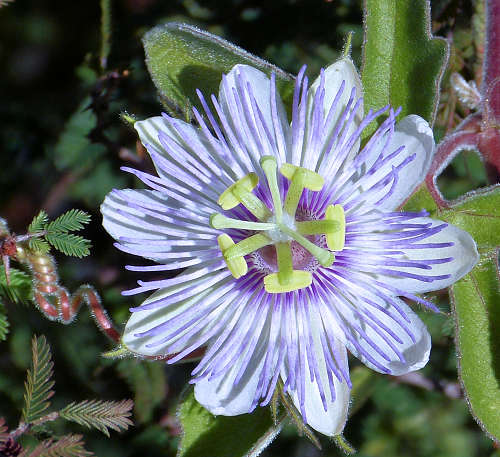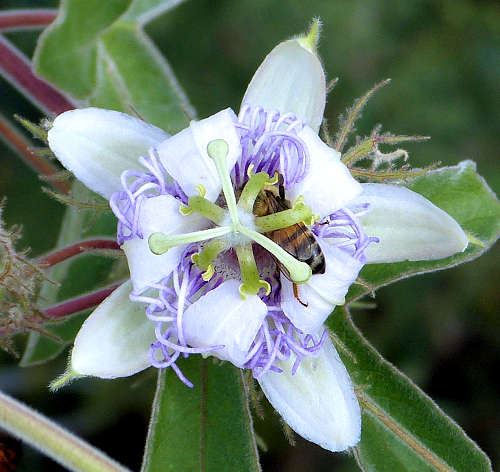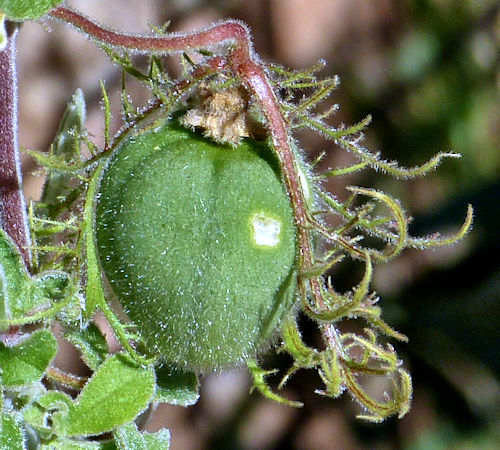Growing Passiflora arizonica:
Arizona Passionflower
Botanical Overview
A member of the Passionflower family (Passifloraceae), the Passiflora genus has
about 500 species, four of which are found growing wild in Arizona: Passiflora arizonica,
P. mexicana, P. bryonioides, and P. arida, which can be mistaken for P. arizonica except that
it blooms during the day and its bracts are not sticky. Arizona Passionflower is unusual
because it is a night bloomer.
Description
Form: A climbing vine.
Lifespan: A short-lived perennial lasting 5-7 years.
Leaf retention: Cold deciduous.
Growth rate: Rapid.
Mature Size: 10' (3m) long.
Flowers: An elaborate, fragrant structure up to 2"
(5cm) in diameter. Ten white tepals (five sepals resembling petals alternating with five
petals) underlay dozens of fleshy filaments showing three color bands (pale blue or purple,
white, purple from outside in). The filaments are crowned by five yellow-green stamens
(pollen-bearing male) underneath three white stigmatas (female).
Bloom: Late summer and fall. This fragrant flower
opens late afternoon for the night and closes after pollination. It may remain open the next
morning if not pollinated. The five sepals open first, followed by the petals (see picture).
Bracts: The flower buds and fruit are surrounded by
thin, tendril-like, many-branched bracts coated with a sticky, smelly fluid, seemingly to
attract tiny insects. Digestive enzymes in the fluid suggest that this plant is poised to
become carnivorous like the Sundew, especially in poor soil conditions.
Fruit: Round to oval shaped, about 1" (2.5cm) in
diameter, poisonous when green. The fruit turns yellowish and falls off the vine when ripe
and edible. The ripe fruit contains a small amount of gelatinous pulp, with a delicate
flavor that is mildly sweet to tart, mixed with many small black seeds.
Leaves: Deeply cut with three major lobes, the side
lobes having secondary lobes, forming 3 to 7 lobes, covered in fine hairs. They are stinky
if crushed.
Stems: Hairy, dry to the touch, green or red, no
thorns, herbaceous, becoming woody with age, with hairy coiling tendrils that assist
climbing.
Roots: Non-invasive. Possible suckers from roots.
Wildlife: The flowers attract night-flying moths.
It is a possible larval host to the Gulf Fritillary butterfly. Bees are known to visit the
flowers before they are fully open if a cloudy late afternoon induces the flowers to open
early (see picture).
Toxic / Danger: All parts are poisonous, containing
cyanide, except for ripe fruit.
Origin: Arizona and Mexico.
Cultivation and Uses
USDA hardiness zones: 8b-10. This plant dies to the
ground in hard freezes and regrows from its roots.
Heat tolerant: Yes.
Drought tolerant: Somewhat, depending on summer rains.
Sun: Full sun.
Water after becoming established: Twice a week to
every two weeks, depending on appearance. More water is needed when fruit are developing.
Soil: Well drained, pH 6.6-7.8 (neutral to slightly
alkaline). This plant is tolerant of soil types but prefers soil with some organic matter.
Mulch: No.
Propagation: Cuttings or seed. The seed may take
several years of freeze/heat and wet/dry cycles to germinate.
Uses: Native plant specimen.
Comments
The former scientific name of Arizona Passionflower was Passiflora foetida var. arizonica.Do you have additional information or a different experience for these plants that you would like to share? Email info@GardenOracle.com. All contributions are welcome and appreciated.




Latest update: January, 2024
© 2008-2024 by GardenOracle.com

